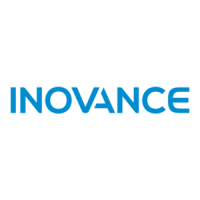2.9 Prototyping Guide
Three control modes are available, namely, V/F, SVC and VC.
When selecting inverter, it must rstly make clear the technical requirements of the system for
variable frequency speed adjustment and specic details regarding the applications and load
characteristics of the inverter, and select the model and determine the operating mode through
taking into overall consideration the adaptable motor, output voltage, rated output current and
other factors.
The basic principle is that the rated load current of the motor shall not exceed the rated current
of the inverter. Generally, the selection is based on the adaptable motor capacity as specied in
the instruction manual. Please pay attention to comparison between the rated currents of motor
and inverter. The overload capacity of the inverter only affects the startup and brake process. In
case short-time overload occurs during the running process, variation of load speed may arise.
If the requirement for the speed precision is relatively high, it can consider increasing the level.
Fan and pump type: Their requirements for the overload capacity are relatively low. Since the
load torque is proportional to the speed, the load is relatively light (except Roots fan) when
running at low speed. In addition, this type of load has no special requirements for the rotation
precision. Thus, square torque V/F is selected.
Constant torque load: Most of loads have constant toque characteristics, but the requirements
for rotation speed and dynamic performance are low. Extruding machine, agitator, belt
conveyer, transporting trolley in the factory, and translational unit of crane are the examples. It
can select MS V/F running mode when performing prototyping test.
The controlled object has certain dynamic and static index requirements: This kind of load
requires harder mechanical characteristics at low speed in order to satisfy the dynamic and
static index requirements of the process for the control system. It can select SVC control mode.
The controlled object has higher dynamic and static index requirements: It can employ VC
control mode in applications where the requirements for speed adjustment precision and
dynamic performance index are relatively high and there is high precision synchronous control.
Elevator, paper making and plastic thin lm processing product line are the examples.
The equipment is damaged because the user fails to comply with the requirements of the a)
user’s manual;
Damage caused by re, ood and abnormal voltage; 3) Damage caused when the inverter b)
is used for abnormal function.
The service expenses will be calculated according to the standard of the manufacturer. If there
is any agreement, the agreement shall prevail.
2.10 Guide to Prototyping of Brake Components
(*): Table 2-5 Inverter Bake Components Prototyping Table provides data for reference, and the
user can select different resistance and power according to the actual needs (but the resistance
shall not be lower than the recommended value, and the power may be higher than the
recommened value). The selection of brake resistor shall be determined in accordance with the
power generated by the motor in the actual application sytem and is associated with the system

